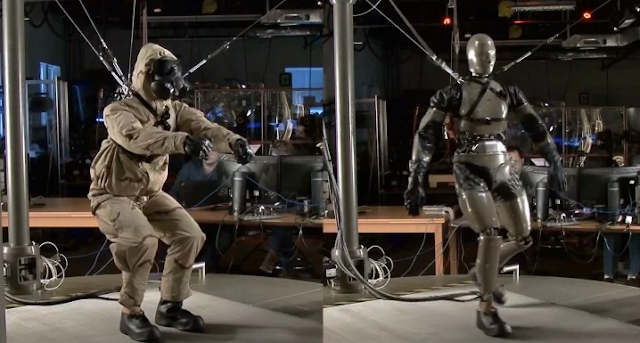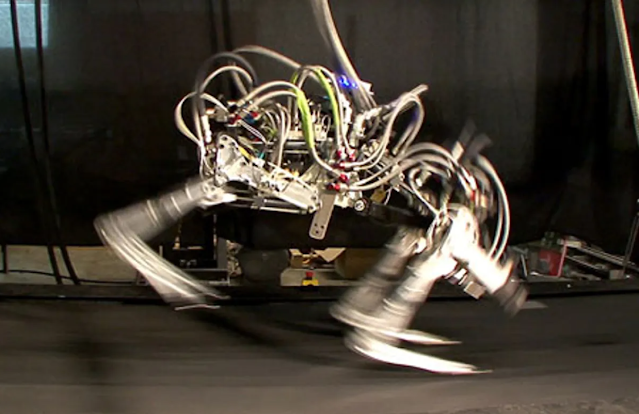Description :
Boston Dynamics is an engineering and robotics design company best known for the development of BigDog, a quadruped robot designed for the U.S. military with funding from DARPA, and DI-Guy, COTS software for realistic human simulation. Early in the company's history, it worked with the American Systems Corporation under a contract from the Naval Air Warfare Center Training Systems Division (NAWCTSD) to replace naval training videos for aircraft launch operations with interactive 3D computer simulations featuring DI-Guy characters.
Marc Raibert is the company's president and project manager. He spun the company off from the Massachusetts Institute of Technology in 1992.
Boston Dynamics builds advanced robots with remarkable behavior: mobility, agility, dexterity and speed. They use sensor-based controls and computation to unlock the capabilities of complex mechanisms. Their world-class development teams take projects from initial concept to proof-of-principle prototyping to build-test-build engineering, to field testing and low-rate
production.
Products
BigDog:
BigDog is a quadruped robot created in 2005 by Boston Dynamics, in conjunction with Foster-Miller, the Jet Propulsion Laboratory, and the Harvard University Concord Field Station. BigDog is funded by the Defense Advanced Research Projects Agency in the hopes that it will be able to serve as a robotic pack mule to accompany soldiers in terrain too rough for vehicles. Instead of wheels, BigDog uses four legs for movement, allowing it to move across surfaces that would defeat wheels.
What has been called "the world's most ambitious legged robot" is designed to carry 340 pounds (150 kg) alongside a soldier at 4 miles per hour (6.4 km/h), traversing rough terrain at inclines up to 35 degrees.
LittleDog:
LittleDog is a small quadruped robot developed for DARPA by Boston Dynamics for research. Unlike BigDog which is run by Boston Dynamics, LittleDog is intended as a testbed for other institutions.
Boston Dynamics maintains the robots for DARPA, as a standard platform.
RiSE:
RiSE is a robot that climbs vertical terrain such as walls, trees and fences. RiSE uses feet with micro-claws to climb on textured surfaces. RiSE changes posture to conform to the curvature of the climbing surface and its tail helps RiSE balance on steep ascents. RiSE is 0.25 m long, weighs 2 kg, and travels 0.3 m/s.
Each of RiSE's six legs is powered by a pair of electric motors. An onboard computer controls leg motion, manages communications, and services a variety of sensors, including joint position sensors, leg strain sensors and foot contact sensors.
Boston Dynamics developed RiSE in conjunction with researchers at University of Pennsylvania, Carnegie Mellon, UC Berkeley, Stanford, and Lewis and Clark College. RiSE was funded by DARPA.
PETMAN:
PETMAN is a bipedal device constructed for testing chemical protection suits. It is able to sweat. It is the first anthropomorphic robot that moves dynamically like a real person.
Much of its technology is derived from BigDog.
LS3:
LS3 is a dynamic robot designed to go anywhere Soldiers and Marines go on foot. Each LS3 will carry up to 400 lbs of gear and enough fuel for missions covering 20 miles and lasting 24 hours. LS3 will not need a driver, because it will automatically follow a leader using computer vision or travel to designated locations using sensing and GPS. The development of LS3 will take 30 months, with first walk out scheduled for 2012. The development of LS3 is being funded by DARPA and the US Marine Corps.
Boston Dynamics has assembled an extraordinary team to develop the LS3, including engineers and scientists from Boston Dynamics, Bell Helicopter, AAI Corporation, Carnegie Mellon Univercity, the Jet Propulsion Laboratory, and Woodward HRT.
RHex (Robot Hexapod):
RHex is a rugged man-portable robot with extraordinary rough terrain mobility. RHex climbs in rock fields, mud, sand, vegetation, railroad tracks, telephone poles and up slopes and stairways. RHex has a sealed body, making it fully operational in wet weather, muddy and swampy conditions, and it can swim on the surface or dive underwater. RHex's remarkable terrain capabilities have been validated in government-run independent testing.
RHex is controlled remotely from an operator control unit at distances up to 600 meters. A video uplink provides front and rear views from onboard cameras. RHex also uplinks navigational data from onboard compass and GPS and from payload sensors. A downlink allows the operator to drive and operate mission payloads.
SquishBot:
SquishBot is a program to develop a new class of soft, shape-changing robot. The goal is to design systems that can transform themselves from hard to soft and from soft to hard, upon command. Another goal is to create systems that change their critical dimensions by large amounts, as much as 10x. Such robots will be like soft animals that can squeeze themselves through small openings and into tight places.
The Boston Dynamics-lead team includes researchers at the Massachusetts Institute of Technology who specialize in novel materials and deformable structures. The program leverages MIT's previous work developing slug robots and Boston Dynamics' work on robots that crawl, walk and climb. SquishBot is funded by the Defense Sciences Office at DARPA as part of the ChemBot program.
Cheetach:
The robot's movements are patterned after those of fast-running animals in nature. The robot increases its stride and running speed by flexing and un-flexing its back on each step, much as an actual cheetah does. The current version of the Cheetah robot runs on a laboratory treadmill where it is powered by an off-board hydraulic pump, and uses a boom-like device to keep it running in the center of the treadmill. Testing of a free-running prototype is planned for later this year.
Cheetach:
The robot's movements are patterned after those of fast-running animals in nature. The robot increases its stride and running speed by flexing and un-flexing its back on each step, much as an actual cheetah does. The current version of the Cheetah robot runs on a laboratory treadmill where it is powered by an off-board hydraulic pump, and uses a boom-like device to keep it running in the center of the treadmill. Testing of a free-running prototype is planned for later this year.
While the M3 program conducts basic research and is not focused on specific military missions, the technology it aims to develop could have a wide range of potential military applications. The video below shows a demonstration of the "Cheetah" robot galloping at speeds of up to 18 miles per hour (mph), setting a new land speed record for legged robots. The previous record was 13.1 mph, set in 1989.
The DARPA M3 performer for Cheetah is Boston Dynamics of Waltham, Mass.
I hope you're not scared. 😛
We have a present for you. Contact us for more!
🎁
😍
*by andreascy*













.png)








